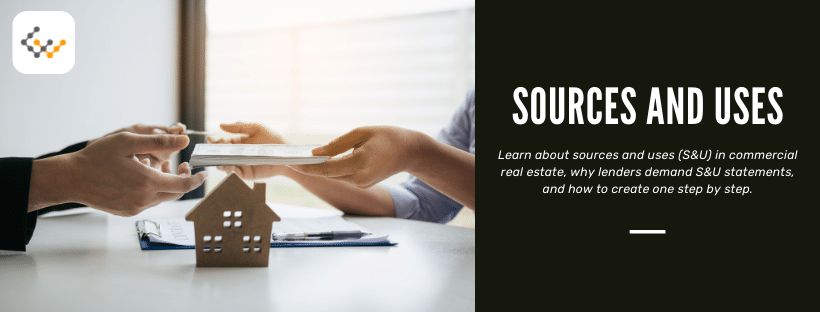Understanding Sources and Uses in Commercial Real Estate

Investing in commercial real estate requires securing and spending large amounts of capital. Sources and uses statement shows how funding for a project is secured and how it’s expected to be used. This is one document that all commercial real estate investors should know how to create, read, and be prepared to supply lenders with.
What Do “Sources and Uses” Refer to in the Context of Commercial Real Estate?
“Sources and uses” is a fairly standard document that outlines where the capital for a project is coming from (the sources) and how this capital will be spent (the uses). It’s a straightforward way to show a project’s anticipated funding and expenses. The document is commonly abbreviated “S&U.”
An S&U statement is presented as a table, making it simple for anyone to review funding and expenses associated with a project. The table is fairly simple, as this is intended to provide a general overview. It doesn’t get into individual items within categories.
Answer a few questions and get custom mortgage quotes. We'll match you with offers from our network of 650+ lenders.
Sources of Funds
The sources of funds that commercial real estate investors have access to are varied. Some common examples include:
- Investor Equity: Money put into the project by its owners or partners.
- Primary Loans: Primary mortgages obtained from banks.
- Specialized Loans: Specialized loans from specific programs.
- Mezzanine Financing: A combination of debt and equity financing.
- Bridge Loans: Short-term financing is used before long-term financing is secured.
- Construction Loans: Funding for new construction or significant renovation.
- Seller Financing: A loan underwritten by the seller rather than a bank.
- SBA Loan: A loan backed by the Small Business Administration (e.g. SBA 7a or 504).
- Government Grants: Specialized government grants that don’t have to be repaid.
- Documented Gift: Funds from friends or family that don’t require repayment.
Uses of Funds
The uses listed on an S&U document provide a bird’s eye view of how funds are to be divided up. Some common expenses include:
- Purchase Price: The amount paid to the seller for the property.
- Closing Costs: Closing costs and related expenses for all loans.
- Working Capital: Funding needed to manage a property initially.
- Construction Costs: Funding needed for new construction.
- Renovation Costs: Funding needed for significant renovation or repair.
- Soft Costs: Miscellaneous expenses for legal fees, engineering consultation, etc.
- Contingency Reserves: Funds set aside to manage unforeseen expenses
- Escrow: Mandatory amount required to be kept in escrow.
Although S&U documents are fairly standardized, there isn’t a strictly defined list of uses that must be included. They’ll be specific to the property, and categories might differ slightly. For example, purchase price and closing costs might be combined as acquisition costs.
Why Do Lenders Require Sources and Uses Statements?
A sources and uses statement is a common lender-required document. There are a few reasons lenders want to see this during underwriting:
- Risk Assessment: Helps lenders evaluate the risk associated with a project.
- Financial Viability: Ensures that there are sufficient funds to cover all costs.
- Transparency: Provides a clear picture of the project’s financial structure.
- Regulatory Compliance: This may be a regulatory requirement in some cases.
How to Create Sources and Uses of Funds Statement
Creating sources and uses statement involves a detailed accounting of all expected revenues and expenses associated with a project.
The two components are shown in a table, and the total funding from sources must match the total expenses under use. Individual sources and uses don’t have to match up, but their sums need to.
Here’s how to create a S&U statement step-by-step:
- List all sources of capital: Begin by listing every potential source of funds, including equity, loans, grants, and other financing methods. Equity investments don’t need to be listed by individual but may be broken out by group if there are several groups of investors.
- Detail all uses of funds: Itemize each type of expense anticipated, ensuring to cover every significant aspect of the project. Individual expenses don’t need to be itemized, but you’ll need quotes or estimates to tabulate each category.
- Balance the statement: The total sources of funds should equal the total uses of funds, indicating that the project is fully financed. If there’s a minor discrepancy in amounts, having a contingency category is one way to ensure the total sources and uses are equal.
- Review and adjust: Reassess the statement to ensure accuracy and feasibility, making adjustments as necessary. Adjustments might be necessary as the purchase process progresses, for instance, if funding changes or additional expenses are anticipated.
Example of Sources and Uses Funds (Sources and Uses Table)
An example of sources and uses a table for a commercial real estate project might look like this:
| Sources of Funds | Amount ($) |
| Primary Bank Loan | 5,000,000 |
| Investor Equity | 2,000,000 |
| Mezzanine Financing | 1,000,000 |
| Total Sources | 8,000,000 |
| Uses of Funds | Amount ($) |
| Property Acquisition | 4,500,000 |
| Construction Costs | 2,000,000 |
| Soft Costs | 250,000 |
| Contingency Reserve | 500,000 |
| Escrow | 750,000 |
| Total Uses | 8,000,000 |
Wrapping Up
When you apply for commercial real estate financing, each lender will likely want sources and uses statement. Investors and other stakeholders might want to see one, and it’s generally an excellent document to think through. Ensure you understand your project’s funding and expenses, and create sources and uses statement that’ll help you clarify and confirm these numbers. The statement isn’t hard to create but can be vitally important to the successful funding and execution of a project.

